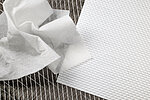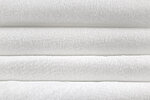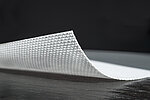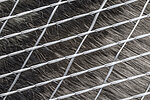Trevira filaments cover a steadily growing spectrum of applications in technical textiles for standards, but also for niche products and for requirements that are constantly becoming more specialised.
Technical applications for Trevira filaments are, for example, special yarns for medicinal and hygiene textiles, together with textured PBT filaments as basis for plasters and bandages containing active ingredients. Meanwhile, demand has been rising steadily for PLA multifilaments. Flame retardant Trevira yarns (Trevira CS) have become the standard material in textiles for exhibition construction and print base.
Hybrid yarns for stiffened materials constitute a rapidly growing specialty, where a yarn from a co-polyester filament, modified at melting point, is combined with another yarn. According to demand, this latter can be either a Trevira standard or flame retardant filament. Combinations with high tenacity filaments, possibly glass and carbon filaments, are also conceivable (and to some extent already realised by industry partners). Textiles made from these components can be shaped almost at will, but in a controlled manner and they can be fixed in this form. In the composites segment such intermediate products are designated thermoplastic prepregs; materials much in demand in modern automotive construction.
Technical applications for flame retardant hybrid yarns in rather textile materials are, for instance, acoustic materials, exhibition construction textiles, and advertising banners. In home textiles interior sun shading can be added to the list. The textiles can be coloured and printed, and there are in addition articles from spun-dyed yarns. Made from 100% polyester, the fabrics can also be recycled without difficulty.
In economic and ecological terms materials in Trevira hybrid yarns provide an interesting alternative to materials with acrylic coatings.
Sewing threads for multiaxial fabrics constitute a further application area for specialised Trevira filaments. These yarns are supplied on spools or alternatively on sectional warp beams, which allows to shorten the supply chain for these composites considerably.




